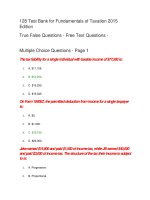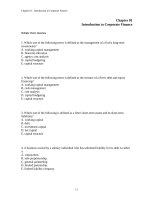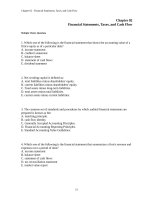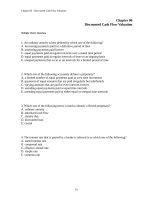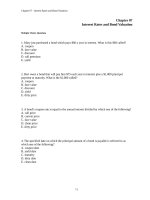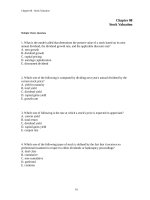TEST BANK FUNDAMENTALS OF TAXATION 2017 EDITION 10TH EDITION CRUZ chap002 anskey
Bạn đang xem bản rút gọn của tài liệu. Xem và tải ngay bản đầy đủ của tài liệu tại đây (261.76 KB, 52 trang )
Chapter 02 Expanded Tax Formula, Forms 1040A and 1040, and Basic Concepts
Answer Key
1) The federal individual income tax returns are the 1040ES, 1040A and 1040.
A) True
B) False
Answer: B
Explanation:
Diff: 1
Topic: Form 1040 and 1040A
Learning Objective: 02-01 Describe the expanded tax formula and the components of the major sections of Form 1040A and Form
1040.
EA: Yes
2) The tax code defines adjusted gross income (AGI) as gross income minus a list of permitted
deductions.
A) True
B) False
Answer: A
Explanation:
Diff: 1
Topic: Form 1040 and 1040A
Learning Objective: 02-01 Describe the expanded tax formula and the components of the major sections of Form 1040A and Form
1040.
EA: Yes
3) The amount of tax liability for a taxpayer depends on many factors, including the filing status of
the taxpayer.
A) True
B) False
Answer: A
Explanation:
Diff: 1
Topic: Filing Status
Learning Objective: 02-02 Determine the proper filing status.
EA: Yes
4) A married couple can file a joint return only if both have earned income.
A) True
B) False
Answer: B
Explanation:
Diff: 1
Topic: Filing Status
Learning Objective: 02-02 Determine the proper filing status.
EA: Yes
1
Copyright © McGraw-Hill Education.All rights reserved. No reproduction or distribution without the prior written consent of McGraw-Hill Education.
5) A married couple in the process of obtaining a divorce cannot file a joint tax return.
A) True
B) False
Answer: B
Explanation:
Diff: 1
Topic: Filing Status
Learning Objective: 02-02 Determine the proper filing status.
EA: Yes
6) A taxpayer filing separately must show the name, address, and social security number of the spouse
on the tax return.
A) True
B) False
Answer: B
Explanation:
Diff: 1
Topic: Filing Status
Learning Objective: 02-02 Determine the proper filing status.
EA: Yes
7) To qualify for head of household status, a taxpayer must maintain a household that is the principal
place of abode of a qualifying person for more than half the year.
A) True
B) False
Answer: A
Explanation:
Diff: 1
Topic: Filing Status
Learning Objective: 02-02 Determine the proper filing status.
EA: Yes
8) A taxpayer can qualify for head of household even though his or her parents are living in a separate
household from that of the taxpayer (assume all other requirements are met).
A) True
B) False
Answer: A
Explanation:
Diff: 1
Topic: Filing Status
Learning Objective: 02-02 Determine the proper filing status.
EA: Yes
9) If a taxpayer's spouse dies during the tax year, the taxpayer must file as a qualifying widow(er).
A) True
B) False
Answer: B
Explanation:
Diff: 1
Topic: Filing Status
Learning Objective: 02-02 Determine the proper filing status.
EA: Yes
10) The exemption amount is subject to annual adjustment for inflation.
A) True
B) False
Answer: A
Explanation:
Diff: 1
Topic: Personal Exemptions
Learning Objective: 02-03 Calculate personal exemptions.
EA: Yes
11) The personal exemption for 2016 is $4,050.
A) True
B) False
Answer: A
Explanation:
Diff: 1
Topic: Personal Exemptions
Learning Objective: 02-03 Calculate personal exemptions.
EA: Yes
12) A taxpayer can be claimed as a dependent on another return and still he or she can claim a personal
exemption on his or her tax return.
A) True
B) False
Answer: B
Explanation:
Diff: 1
Topic: Depending Exemptions
Learning Objective: 02-04 Calculate dependency exemptions.
EA: Yes
13) To be claimed as a dependent, a person must be a qualifying child or a qualifying relative.
A) True
B) False
Answer: A
Explanation:
Diff: 1
Topic: Depending Exemptions
Learning Objective: 02-04 Calculate dependency exemptions.
EA: Yes
14) A qualifying child does not have to meet the support test in order to be claimed as a dependent.
A) True
B) False
Answer: B
Explanation:
Diff: 1
Topic: Depending Exemptions
Learning Objective: 02-04 Calculate dependency exemptions.
EA: Yes
15) A qualifying relative must be related to the taxpayer (as listed by the IRS), or be a member of the
taxpayer's household for the entire year.
A) True
B) False
Answer: A
Explanation:
Diff: 1
Topic: Depending Exemptions
Learning Objective: 02-04 Calculate dependency exemptions.
EA: Yes
16) A taxpayer who either is 65 or older or blind can claim an additional standard deduction.
A) True
B) False
Answer: A
Explanation:
Diff: 1
Topic: Standard Deduction
Learning Objective: 02-05 Determine the standard deductions.
EA: Yes
4
Copyright © McGraw-Hill Education.All rights reserved. No reproduction or distribution without the prior written consent of McGraw-Hill Education.
17) The standard deduction in 2016 for a married couple, under 65 and not blind, is $12,600.
A) True
B) False
Answer: A
Explanation:
Diff: 1
Topic: Standard Deduction
Learning Objective: 02-05 Determine the standard deductions.
EA: Yes
18) In 2016, the additional standard deduction for a single taxpayer, who is 65 or older and not blind, is
$1,200.
A) True
B) False
Answer: B
Explanation:
Diff: 1
Topic: Standard Deduction
Learning Objective: 02-05 Determine the standard deductions.
EA: Yes
19) Even if the total of the itemized deductions is lower than the standard deduction, a taxpayer should
choose to itemize on his or her tax return.
A) True
B) False
Answer: B
Explanation:
Diff: 1
Topic: Standard Deduction
Learning Objective: 02-05 Determine the standard deductions.
EA: Yes
20) The tax tables stop at taxable income of $115,000.
A) True
B) False
Answer: B
Explanation:
Diff: 1
Topic: Tax Due to IRS
Learning Objective: 02-06 Compute the amount of tax due to the Internal Revenue Service (IRS).
EA: Yes
5
Copyright © McGraw-Hill Education.All rights reserved. No reproduction or distribution without the prior written consent of McGraw-Hill Education.
21) Most taxpayers make payments to the IRS through income tax withholdings and quarterly
estimated tax payments.
A) True
B) False
Answer: A
Explanation:
Diff: 1
Topic: Tax Due to IRS
Learning Objective: 02-06 Compute the amount of tax due to the Internal Revenue Service (IRS).
EA: Yes
22) A taxpayer may request an automatic seven-month extension of time to file his or her tax return.
A) True
B) False
Answer: B
Explanation:
Diff: 1
Topic: Tax Due to IRS
Learning Objective: 02-06 Compute the amount of tax due to the Internal Revenue Service (IRS).
EA: Yes
23) An extension to file a tax return is an extension of time to file and an extension of time to pay.
A) True
B) False
Answer: B
Explanation:
Diff: 1
Topic: Tax Due to IRS; Interest and Penalties
Learning Objective: 02-06 Compute the amount of tax due to the Internal Revenue Service (IRS).; 02-07 Determine what interest and
penalties the IRS can assess and in what instances certain penalties are applicable.
EA: Yes
24) The maximum penalty for failure to file a tax return that is not due to fraud is 25%.
A) True
B) False
Answer: A
Explanation:
Diff: 1
Topic: Interest and Penalties
Learning Objective: 02-07 Determine what interest and penalties the IRS can assess and in what instances certain penalties are
applicable.
EA: Yes
25) The IRS can impose a 75% penalty on any portion of understatement of tax that is attributable to
negligence.
A) True
B) False
Answer: B
Explanation:
Diff: 1
Topic: Interest and Penalties
Learning Objective: 02-07 Determine what interest and penalties the IRS can assess and in what instances certain penalties are
applicable.
EA: Yes
26) Taxable income (TI) is computed after subtracting from adjusted gross income (AGI), the standard
deduction or itemized deductions and personal and dependency exemptions.
A) True
B) False
Answer: A
Explanation:
Diff: 1
Topic: Form 1040 and 1040A
Learning Objective: 02-01 Describe the expanded tax formula and the components of the major sections of Form 1040A and Form
1040.
EA: Yes
27) When a taxpayer's AGI exceeds certain levels, certain tax benefits are reduced or eliminated.
A) True
B) False
Answer: A
Explanation:
Diff: 1
Topic: Form 1040 and 1040A
Learning Objective: 02-01 Describe the expanded tax formula and the components of the major sections of Form 1040A and Form
1040.
EA: Yes
28) Marital status of a taxpayer is determined on the last day of the tax year.
A) True
B) False
Answer: A
Explanation:
Diff: 1
Topic: Filing Status
Learning Objective: 02-02 Determine the proper filing status.
EA: Yes
29) A couple who is legally married on the last day of the tax year cannot file married filing separately.
A) True
B) False
Answer: B
Explanation:
Diff: 1
Topic: Filing Status
Learning Objective: 02-02 Determine the proper filing status.
EA: Yes
30) Even though the taxpayer is claimed as a dependent on another tax return, he or she can still
receive an exemption amount for himself or herself when filing his or her tax return.
A) True
B) False
Answer: B
Explanation:
Diff: 2
Topic: Personal Exemptions
Learning Objective: 02-03 Calculate personal exemptions.
EA: Yes
31) In a multiple support agreement, the taxpayer who will receive the exemption must file all the
Forms 2120 with his or her tax return.
A) True
B) False
Answer: A
Explanation:
Diff: 2
Topic: Depending Exemptions
Learning Objective: 02-04 Calculate dependency exemptions.
EA: Yes
32) The taxpayer's brother must live with the taxpayer for the entire year to meet the relationship or
member of household test under qualifying relatives.
A) True
B) False
Answer: B
Explanation:
Diff: 2
Topic: Depending Exemptions
Learning Objective: 02-04 Calculate dependency exemptions.
EA: Yes
33) If a married couple files separate returns and one of them itemizes, the other spouse must also
itemize.
A) True
B) False
Answer: A
Explanation:
Diff: 1
Topic: Standard Deduction
Learning Objective: 02-05 Determine the standard deductions.
EA: Yes
34) A taxpayer who has income that is not subject to withholding is never required to make estimated
payments during the year.
A) True
B) False
Answer: B
Explanation:
Diff: 1
Topic: Tax Due to IRS
Learning Objective: 02-06 Compute the amount of tax due to the Internal Revenue Service (IRS).
EA: Yes
35) If the taxpayer still owes tax after April 15, the IRS assesses interest based on the remaining
amount owed.
A) True
B) False
Answer: A
Explanation:
Diff: 1
Topic: Interest and Penalties
Learning Objective: 02-07 Determine what interest and penalties the IRS can assess and in what instances certain penalties are
applicable.
EA: Yes
36) Many deductions and credits are determined with reference to adjusted gross income (AGI).
A) True
B) False
Answer: A
Explanation:
Diff: 1
Topic: Form 1040 and 1040A
Learning Objective: 02-01 Describe the expanded tax formula and the components of the major sections of Form 1040A and Form
1040.
EA: Yes
37) A taxpayer must be married to claim Head of Household status.
A) True
B) False
Answer: B
Explanation:
Diff: 1
Topic: Filing Status
Learning Objective: 02-02 Determine the proper filing status.
EA: Yes
38) Personal exemptions are for the taxpayer and spouse.
A) True
B) False
Answer: A
Explanation:
Diff: 1
Topic: Personal Exemptions
Learning Objective: 02-03 Calculate personal exemptions.
EA: Yes
39) The amount of the standard deduction increases for people who are age 62 and have retired.
A) True
B) False
Answer: B
Explanation:
Diff: 1
Topic: Standard Deduction
Learning Objective: 02-05 Determine the standard deductions.
EA: Yes
40) The accuracy-related penalty applies when negligence or any substantial understatement occurs.
A) True
B) False
Answer: A
Explanation:
Diff: 2
Topic: Interest and Penalties
Learning Objective: 02-07 Determine what interest and penalties the IRS can assess and in what instances certain penalties are
applicable.
EA: Yes
41) A single taxpayer is 43 years old and has wages only of $16,000. Which is the simplest form this
person can file?
A) 1040.
B) 1040ES.
C) 1040EZ.
D) 1040A.
Answer: C
Explanation: A)
B)
C)
D)
Diff: 1
Topic: Form 1040 and 1040A
Learning Objective: 02-01 Describe the expanded tax formula and the components of the major sections of Form 1040A and Form
1040.
EA: Yes
42) A 36-year-old taxpayer with a dependent child and claiming head of household status has received
$29,000 in alimony payments and earned wages of $44,000. Which is the simplest form this person
can file?
A) 1040.
B) 1040A.
C) 1040ES.
D) 1040EZ.
Answer: A
Explanation: A) Alimony is reported on Form 1040.
B) Alimony is reported on Form 1040.
C) Alimony is reported on Form 1040.
D) Alimony is reported on Form 1040.
Diff: 1
Topic: Form 1040 and 1040A
Learning Objective: 02-01 Describe the expanded tax formula and the components of the major sections of Form 1040A and Form
1040.
EA: Yes
43) A taxpayer is married with a qualifying child (dependent), but she has been living separate from
her spouse for the last five months of the year. However, she paid for more than half of the cost of
keeping up the household. Her spouse does not want to file jointly. What filing status must she use
when filing her tax return? She wants to obtain the maximum legal benefit.
A) Single.
B) Head of Household.
C) Qualifying Widow(er).
D) Married Filing
Separately. Answer: D
Explanation: A) The taxpayer must have lived apart from her spouse for at least the last six months
of the year to qualify for the Head of Household status.
B) The taxpayer must have lived apart from her spouse for at least the last six months
of the year to qualify for the Head of Household status.
C) The taxpayer must have lived apart from her spouse for at least the last six months
of the year to qualify for the Head of Household status.
D) The taxpayer must have lived apart from her spouse for at least the last six months
of the year to qualify for the Head of Household status.
Diff: 1
Topic: Filing Status
Learning Objective: 02-02 Determine the proper filing status.
EA: Yes
44) The taxpayer's spouse died at the beginning of 2015. He has no qualifying child. Which status
should the taxpayer select when filing his tax return for 2016?
A) Married Filing Separately.
B) Qualifying Widow(er).
C) Single.
D) Married Filing Jointly.
Answer: C
Explanation: A) The surviving spouse usually can file a joint return in the year the spouse dies and
qualifying widow(er) for the two years following the death of the spouse but only
if there is a qualifying child.
B) The surviving spouse usually can file a joint return in the year the spouse dies and
qualifying widow(er) for the two years following the death of the spouse but only
if there is a qualifying child.
C) The surviving spouse usually can file a joint return in the year the spouse dies and
qualifying widow(er) for the two years following the death of the spouse but only
if there is a qualifying child.
D) The surviving spouse usually can file a joint return in the year the spouse dies and
qualifying widow(er) for the two years following the death of the spouse but only
if there is a qualifying child.
Diff: 1
Topic: Filing Status
Learning Objective: 02-02 Determine the proper filing status.
EA: Yes
45) A legally divorced taxpayer maintains a household for himself and maintains a separate household
that is the principal place of abode of his dependent widowed mother. What filing status should he
use when filing his tax return?
A) Head of Household.
B) Qualifying widow(er).
C) Single.
D) Married Filing
Separately. Answer: A
Explanation: A) The taxpayer's parents can live in a separate household.
B) The taxpayer's parents can live in a separate household.
C) The taxpayer's parents can live in a separate household.
D) The taxpayer's parents can live in a separate household.
Diff: 1
Topic: Filing Status
Learning Objective: 02-02 Determine the proper filing status.
EA: Yes
46) For tax purposes, marital status is determined as of the ________ day of the year.
A) third
B) first
C) last
D) None of these
Answer: C
Explanation:
A)
B)
C)
D)
Diff: 1
Topic: Filing Status
Learning Objective: 02-02 Determine the proper filing status.
EA: Yes
47) What was the amount of the personal exemption for
2016? A) $3,975.
B) $4,050.
C) $4,000.
D) $3,900.
Answer: B
Explanation:
A)
B)
C)
D)
Diff: 1
Topic: Personal Exemptions
Learning Objective: 02-03 Calculate personal exemptions.
EA: Yes
48) Elisa is 21 years of age and a full-time student living with her parents. She had wages of $680 ($70
of income tax withholding) for 2016. Can Elisa claim her exemption on her return even though her
parents will claim her as a dependent on their tax return?
A) No one can claim the exemption for Elisa.
B) No, Elisa cannot claim the exemption.
C) Yes, Elisa can claim the exemption.
D) Elisa and her parents can both claim the exemption.
Answer: B
Explanation: A) Elisa cannot claim the exemption for herself because she is a dependent of her
parents.
B) Elisa cannot claim the exemption for herself because she is a dependent of her
parents.
C) Elisa cannot claim the exemption for herself because she is a dependent of her
parents.
D) Elisa cannot claim the exemption for herself because she is a dependent of her
parents.
Diff: 2
Topic: Personal Exemptions
Learning Objective: 02-03 Calculate personal exemptions.
EA: Yes
49) A taxpayer can deduct a(an)
A) Deduction
B) Exemption
C) Adjustment
D) Itemized
Answer: B
Explanation: A)
B)
C)
D)
amount from AGI for each dependent.
Diff: 1
Topic: Depending Exemptions
Learning Objective: 02-04 Calculate dependency exemptions.
EA: Yes
50) Mirtha is 21 years of age and a full-time student living by herself. She had wages of $25,000 for
2016. Can Mirtha claim the exemption for herself on her tax return?
A) Both, Mirtha and her parents can claim the exemption.
B) Mirtha's parents can claim the exemption.
C) No one can claim the exemption for Mirtha.
D) Yes, Mirtha can claim the exemption.
Answer: D
Explanation: A) Mirtha can claim the exemption because she provided more than half of her
support.
B) Mirtha can claim the exemption because she provided more than half of her
support.
C) Mirtha can claim the exemption because she provided more than half of her
support.
D) Mirtha can claim the exemption because she provided more than half of her
support.
Diff: 2
Topic: Personal Exemptions
Learning Objective: 02-03 Calculate personal exemptions.
EA: Yes
51) To be a qualifying child, the taxpayer must meet three general tests and five specific tests. Which
one is not part of the five specific tests?
A) Gross income test.
B) Special test for qualifying child of more than one taxpayer.
C) Relationship test.
D) Residency test.
Answer: A
Explanation: A)
B)
C)
D)
Diff: 1
Topic: Depending Exemptions
Learning Objective: 02-04 Calculate dependency exemptions.
EA: Yes
16
Copyright © McGraw-Hill Education.All rights reserved. No reproduction or distribution without the prior written consent of McGraw-Hill Education.
52) To be a qualifying child, the taxpayer must meet three general tests and five specific tests. What are
the three general tests?
A) Dependent taxpayer test, relationship test and citizen or resident test.
B) Support test, age test and relationship test.
C) Relationship test, residency test and gross income test.
D) Dependent taxpayer test, joint return test and citizen or resident test.
Answer: D
Explanation: A)
B)
C)
D)
Diff: 1
Topic: Depending Exemptions
Learning Objective: 02-04 Calculate dependency exemptions.
EA: Yes
53) To be a qualifying relative, the taxpayer must meet three general tests and four specific tests.
Which one is not part of the four specific tests?
A) Relationship test or member of household test.
B) Support test.
C) Age test.
D) Gross income test.
Answer: C
Explanation: A)
B)
C)
D)
Diff: 1
Topic: Depending Exemptions
Learning Objective: 02-04 Calculate dependency exemptions.
EA: Yes
17
Copyright © McGraw-Hill Education.All rights reserved. No reproduction or distribution without the prior written consent of McGraw-Hill Education.
54) For a qualifying relative to be claimed as a dependent, this person must either be related to the
taxpayer, or be a member of the taxpayer's household for the entire year. Select the relative who
must be part of the taxpayer's household for the entire year.
A) Son-in-law.
B) Mother.
C) Sister.
D) Cousin.
Answer: D
Explanation: A) Cousins are not listed as relatives for this IRS section.
B) Cousins are not listed as relatives for this IRS section.
C) Cousins are not listed as relatives for this IRS section.
D) Cousins are not listed as relatives for this IRS section.
Diff: 2
Topic: Depending Exemptions
Learning Objective: 02-04 Calculate dependency exemptions.
EA: Yes
55) The taxpayer must provide over
dependency exemption.
A) 49%
B) 51%
C) 75%
D) 50%
Answer: D
Explanation:
of the qualifying relative's support to be able to claim a
A)
B)
C)
D)
Diff: 1
Topic: Depending Exemptions
Learning Objective: 02-04 Calculate dependency exemptions.
EA: Yes
56) Which of the following items would not be considered as support for a dependency exemption?
A) food.
B) clothing.
C) medical insurance premiums.
D) life insurance
premiums. Answer: D
Explanation: A) Life insurance premiums are not considered support under this IRS section.
B) Life insurance premiums are not considered support under this IRS section.
C) Life insurance premiums are not considered support under this IRS section.
D) Life insurance premiums are not considered support under this IRS section.
Diff: 1
Topic: Depending Exemptions
Learning Objective: 02-04 Calculate dependency exemptions.
EA: Yes
57) Robert, Fred and Lucas are supporting their mother who lives in a separate apartment. Their
contributions towards her support are 10%, 40% and 50%, respectively. In a multiple support
agreement, who would be entitled to claim the mother as a dependent?
A) Robert, Fred or Lucas.
B) Fred or Lucas.
C) Robert.
D) None of these.
Answer: B
Explanation: A) Robert is not contributing more than 10% of his mother's support.
B) Robert is not contributing more than 10% of his mother's support.
C) Robert is not contributing more than 10% of his mother's support.
D) Robert is not contributing more than 10% of his mother's support.
Diff: 2
Topic: Depending Exemptions
Learning Objective: 02-04 Calculate dependency exemptions.
EA: Yes
58) The basic standard deduction in 2016 for a single taxpayer, under 65 and not blind,
is: A) $6,300.
B) $6,200.
C) $4,050.
D) $9,300.
Answer: A
Explanation: A)
B)
C)
D)
Diff: 1
Topic: Standard Deduction
Learning Objective: 02-05 Determine the standard deductions.
EA: Yes
59) The basic standard deduction in 2016 for a taxpayer, under 65 and not blind, filing married filing
jointly is:
A) $9,300.
B) $12,200.
C) $12,400.
D) $12,600.
Answer: D
Explanation:
A)
B)
C)
D)
Diff: 1
Topic: Standard Deduction
Learning Objective: 02-05 Determine the standard deductions.
EA: Yes
60) The basic standard deduction in 2016 for a taxpayer, 67 and not blind, filing head of household is:
A) $9,250.
B) $1,550.
C) $9,300.
D) $10,850.
Answer: D
Explanation: A) Standard deduction of $9,300 plus the additional amount of $1,550.
B) Standard deduction of $9,300 plus the additional amount of $1,550.
C) Standard deduction of $9,300 plus the additional amount of $1,550.
D) Standard deduction of $9,300 plus the additional amount of $1,550.
Diff: 1
Topic: Standard Deduction
Learning Objective: 02-05 Determine the standard deductions.
EA: Yes
61) When a taxpayer can be claimed as a dependent on the tax return of another individual, the basic
standard deduction for the taxpayer is limited to the greater of (a)
, or (b) the taxpayer's
earned income plus $350, but not more than the amount of the basic standard deduction.
A) $1,050
B) $1,000
C) $350
D) $950
Answer: A
Explanation: A)
B)
C)
D)
Diff: 1
Topic: Standard Deduction
Learning Objective: 02-05 Determine the standard deductions.
EA: Yes
62) Luisa's parents can claim her as a dependent on their tax return. In 2016, her only source of income
was a part-time job as a medical clerk where she earned $2,600 during the year. What is Luisa's
standard deduction?
A) $4,050.
B) $1,050.
C) $2,950.
D) $2,600.
Answer: C
Explanation:
A) Earned income of $2,600 plus $350.
B) Earned income of $2,600 plus $350.
C) Earned income of $2,600 plus $350.
D) Earned income of $2,600 plus $350.
Diff: 2
Topic: Standard Deduction
Learning Objective: 02-05 Determine the standard deductions.
EA: Yes
63) Ed's parents can claim him as a dependent on their tax return. In 2016, his only source of income
was $1,050 of interest income received from Global Bank. What is Ed's standard deduction?
A) $1,050.
B) $1,000.
C) $350.
D) $4,050.
Answer: A
Explanation: A) Ed has zero earned income.
B) Ed has zero earned income.
C) Ed has zero earned income.
D) Ed has zero earned income.
Diff: 2
Topic: Standard Deduction
Learning Objective: 02-05 Determine the standard deductions.
EA: Yes
64) What is the amount of the social security wage limitation for 2016?
A) $118,500.
B) $117,000.
C) $110,100.
D)
$106,800.
Answer: A
Explanation: A)
B)
C)
D)
Diff: 1
Topic: Tax Due to IRS
Learning Objective: 02-06 Compute the amount of tax due to the Internal Revenue Service (IRS).
EA: Yes
65) What is the amount of the tax liability for a married couple having taxable income of $153,500?
All answers should be rounded to the nearest dollar.
A)
$30,233.
B) $29,966.
C) $38,375.
D)
$30,032.
Answer: B
Explanation: A) ($153,500 - $151,900) × 28% plus
$29,517.50. B) ($153,500 - $151,900) × 28%
plus $29,517.50. C) ($153,500 - $151,900) ×
28% plus $29,517.50. D) ($153,500 - $151,900)
× 28% plus $29,517.50.
Diff: 3
Topic: Tax Due to IRS
Learning Objective: 02-06 Compute the amount of tax due to the Internal Revenue Service (IRS).
EA: Yes
66) What is the amount of the tax liability for a single person having taxable income of $59,200? All
answers should be rounded to the nearest dollar.
Use the appropriate Tax Tables or Tax Rate Schedules.
A)
$10,656.
B) $10,578.
C) $14,800.
D) $9,300.
Answer: B
Explanation:
A) Look up $59,200 under the tax tables for a single person.
B) Look up $59,200 under the tax tables for a single person.
C) Look up $59,200 under the tax tables for a single person.
D) Look up $59,200 under the tax tables for a single person.
Diff: 3
Topic: Tax Due to IRS
Learning Objective: 02-06 Compute the amount of tax due to the Internal Revenue Service (IRS).
EA: Yes
67) What is the amount of the tax liability for a head of household person having taxable income of
$87,573? All answers should be rounded to the nearest dollar.
Use the appropriate Tax Tables or Tax Rate Schedules.
A) $16,398
B) $16,179.
C) $16,306.
D)
$16,191.
Answer: D
Explanation:
A) Look up $87,573 under the tax tables for a head of household person.
B) Look up $87,573 under the tax tables for a head of household person.
C) Look up $87,573 under the tax tables for a head of household person.
D) Look up $87,573 under the tax tables for a head of household person.
Diff: 3
Topic: Tax Due to IRS
Learning Objective: 02-06 Compute the amount of tax due to the Internal Revenue Service (IRS).
EA: Yes
68) What is the amount of the tax liability for a qualifying widow(er) with a dependent child and having
taxable income of $18,355? All answers should be rounded to the nearest dollar.
Use the appropriate Tax Tables or Tax Rate Schedules.
A) $2,331.
B) $1,838.
C) $2,753.
D) $1,836.
Answer: B
Explanation:
A) Look up $18,355 under the tax tables for married
used for qualifying widow(er)).
B) Look up $18,355 under the tax tables for married
used for qualifying widow(er)).
C) Look up $18,355 under the tax tables for married
used for qualifying widow(er)).
D) Look up $18,355 under the tax tables for married
used for qualifying widow(er)).
filing jointly (this column also is
filing jointly (this column also is
filing jointly (this column also is
filing jointly (this column also is
Diff: 3
Topic: Tax Due to IRS
Learning Objective: 02-06 Compute the amount of tax due to the Internal Revenue Service (IRS).
EA: Yes
69) What is the amount of the tax liability for a qualifying widow(er) with a dependent child and
having taxable income of $121,600? All answers should be rounded to the nearest dollar.
A)
$21,943.
B) $30,400.
C) $27,665.
D)
$25,234.
Answer: A
Explanation: A) ($121,600 - $75,300) × 25% plus $10,367.50.
B) ($121,600 - $75,300) × 25% plus $10,367.50.
C) ($121,600 - $75,300) × 25% plus $10,367.50.
D) ($121,600 - $75,300) × 25% plus $10,367.50.
Diff: 3
Topic: Tax Due to IRS
Learning Objective: 02-06 Compute the amount of tax due to the Internal Revenue Service (IRS).
EA: Yes
